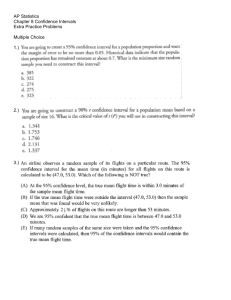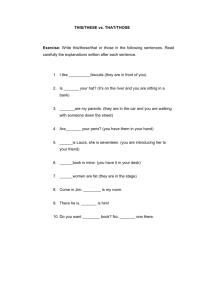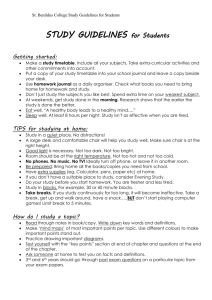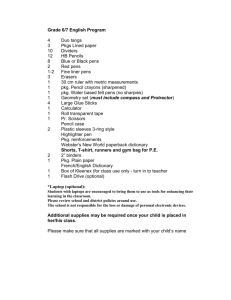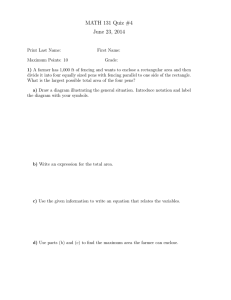MASSACHUSETTS INSTITUTE OF TECHNOLOGY 6.436J/15.085J Fall 2008 Problem Set 4
advertisement
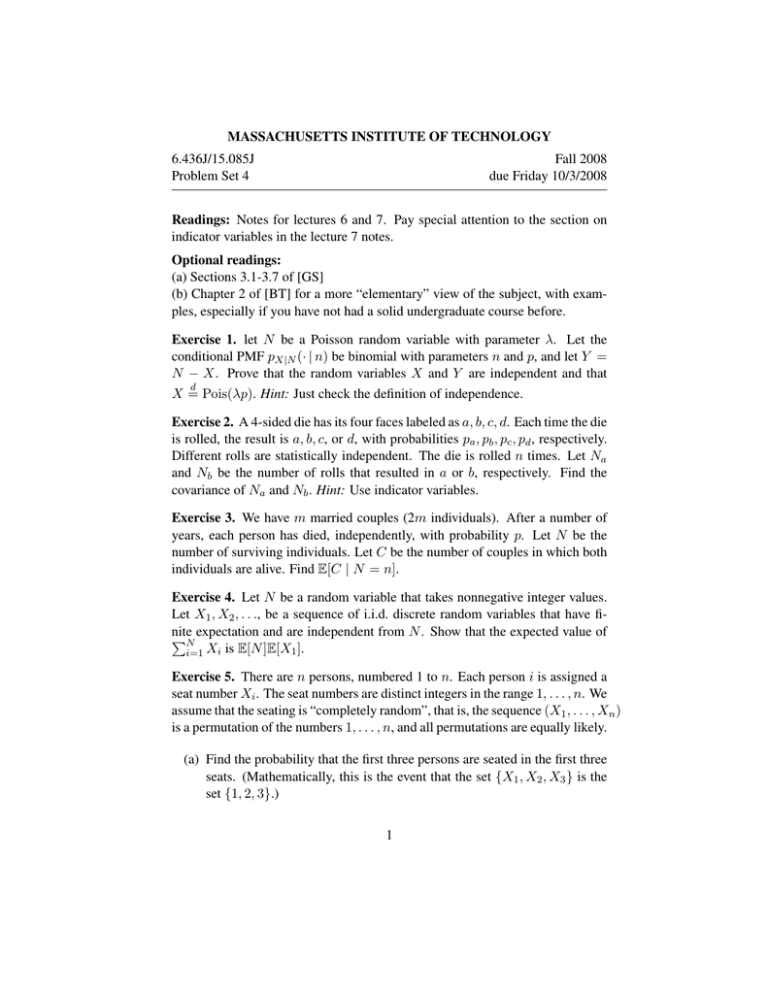
MASSACHUSETTS INSTITUTE OF TECHNOLOGY
6.436J/15.085J
Problem Set 4
Fall 2008
due Friday 10/3/2008
Readings: Notes for lectures 6 and 7. Pay special attention to the section on
indicator variables in the lecture 7 notes.
Optional readings:
(a) Sections 3.1-3.7 of [GS]
(b) Chapter 2 of [BT] for a more “elementary” view of the subject, with exam­
ples, especially if you have not had a solid undergraduate course before.
Exercise 1. let N be a Poisson random variable with parameter λ. Let the
conditional PMF pX|N (· | n) be binomial with parameters n and p, and let Y =
N − X. Prove that the random variables X and Y are independent and that
d
X = Pois(λp). Hint: Just check the definition of independence.
Exercise 2. A 4-sided die has its four faces labeled as a, b, c, d. Each time the die
is rolled, the result is a, b, c, or d, with probabilities pa , pb , pc , pd , respectively.
Different rolls are statistically independent. The die is rolled n times. Let Na
and Nb be the number of rolls that resulted in a or b, respectively. Find the
covariance of Na and Nb . Hint: Use indicator variables.
Exercise 3. We have m married couples (2m individuals). After a number of
years, each person has died, independently, with probability p. Let N be the
number of surviving individuals. Let C be the number of couples in which both
individuals are alive. Find E[C | N = n].
Exercise 4. Let N be a random variable that takes nonnegative integer values.
Let X1 , X2 , . . ., be a sequence of i.i.d. discrete random variables that have fi­
nite
�N expectation and are independent from N . Show that the expected value of
i=1 Xi is E[N ]E[X1 ].
Exercise 5. There are n persons, numbered 1 to n. Each person i is assigned a
seat number Xi . The seat numbers are distinct integers in the range 1, . . . , n. We
assume that the seating is “completely random”, that is, the sequence (X1 , . . . , Xn )
is a permutation of the numbers 1, . . . , n, and all permutations are equally likely.
(a) Find the probability that the first three persons are seated in the first three
seats. (Mathematically, this is the event that the set {X1 , X2 , X3 } is the
set {1, 2, 3}.)
1
(b) Are the events {X1 < X2 } and {X3 < X4 } independent? Provide a brief
justification.
(c) Are X1 and X2 conditionally independent, given the random variables X3
and X4 ? Provide a brief justification.
(d) Consider the first 10 people, i = 1, . . . , 10. Find the probability that
exactly 5 of the first 10 people are seated in seats with numbers in the
range 1, . . . , 8. (You do not need to simplify your answer.)
(e) For any i and j, with 1 ≤ i < j ≤ n, we say that we have an inversion if
Xi > Xj . Let N be the number of inversions. Find E[N ] and E[N 2 ].
The following formula may prove useful:
n
�
i=1
i=
n(n + 1)
.
2
Exercise 6. (Another application of the “probabilistic method” in combina­
torics.) Let G be an undirected graph with neither loops nor multiple edges, and
write dv for the degree of the vertex v. An independent set is a set of vertices no
pair of which is joined by an edge. Let α(G) be the size of the largest
indepen­
�
dent set of G. Use the probabilistic method to show that α(G) ≥ v 1/(1+dv ).
Hint: Order the nodes at random, and examine the nodes one at a time, putting
them in the independent set as long as there are no conflicts with previously
examined nodes. Find the expected value of the resulting set.
Exercise 7. A factory has produced n robots, each of which is faulty with prob­
ability φ. To each robot a test is applied which detects the fault (if present) with
probability δ. Let X be the number of faulty robots, and Y the number detected
as faulty. Show that
E[X | Y ] =
nφ(1 − δ) + (1 − φ)Y
,
1 − φδ
after stating explicitly any independence assumptions you are making.
2
In addition, you need to be sure that you can solve elementary problems. As a
check, make sure you are able to solve the next problem (not to be handed in).
Drill problem: At his workplace, the first thing Oscar does every morning is to
go to the supply room and pick up one, two, or three pens with equal probability
1/3. If he picks up three pens, he does not return to the supply room again that
day. If he picks up one or two pens, he will make one additional trip to the supply
room, where he again will pick up one, two, or three pens with equal probability
1/3. (The number of pens taken in one trip will not affect the number of pens
taken in any other trip.) Calculate the following:
(a) The probability that Oscar gets a total of three pens on any particular day.
(b) The conditional probability that he visited the supply room twice on a
given day, given that it is a day in which he got a total of three pens.
(c) E[N ] and E[N | C], where E[N ] is the unconditional expectation of N ,
the total number of pens Oscar gets on any given day, and E[N | C] is the
conditional expectation of N given the event C = {N > 3}.
(d) σN |C , the conditional standard deviation of the total number of pens Oscar
gets on a particular day, where N and C are as in part (c).
(e) The probability that he gets more than three pens on each of the next 16
days.
(f) The conditional standard deviation of the total number of pens he gets in
the next 16 days given that he gets more than three pens on each of those
days.
3
MIT OpenCourseWare
http://ocw.mit.edu
6.436J / 15.085J Fundamentals of Probability
Fall 2008
For information about citing these materials or our Terms of Use, visit: http://ocw.mit.edu/terms.
